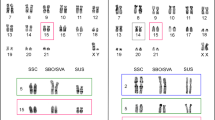Abstract
Two satellite DNAs, designated CapA and CapB, were isolated from the neotropical primate,Cebus apella. The satellites exhibit nonoverlapping distributions onC. apella chromosomes. CapA is a major component of interstitial regions of constitutive heterochromatin, a very large block of heterochromatin comprising most of the long arm of chromosome 11, and some telomeres. The CapA monomer has a length of about 1500 bp and appears recently to have undergone an amplification episode in theC. apella genome. CapA-like sequences are probably present in members of the family Cebidae (to whichC. apella belongs), but not in members of the family Callitrichidae (marmosets). CapB sequences can be detected at the centromeres of manyC. apella chromosomes, and similar sequences are present in all neotropical primates. The 342 bp CapB monomer shares 60%–64% sequence identity with several alpha satellite sequences of human origin. Because of its structure, sequence, and location, it appears that CapB is the New World primate homolog of Old World primate alpha satellite DNA.
Similar content being viewed by others
References
Bachvarov DR, Markov GG, Ivanov IG (1987) Sequence, heterogeneity of the human alphoid satellite DNA and thermal stability of mismatched alphoid DNA duplexes. Int J Biochem 19: 963–971
Boyle AL, Ballard SG, Ward DC (1990) Differential distribution of long and short interspersed element sequences in the mouse genome: chromosome karyotyping by fluorescence in situ hybridization. Proc Natl Acad Sci USA 87: 7757–7761
Delattre O, Bernard A, Malfoy B, Marlhens F, Viegas-Pequignot E, Brossard C, Haguenauer O, Creau-Goldberg N, Van Cong N, Dutrillaux B, Thomas G (1987) Isolation and characterization of an alphoid DNA sequence recently amplified on human chromosome 3. Nucleic Acids Res 15: 8561
Donchower L, Furlong C, Gillespie D, Kurnit D (1980) DNA sequence of baboon highly repeated DNA: evidence for evolution by nonrandom unequal crossovers. Proc Natl Acad Sci USA 77: 2129–2133
Fleagle JG (1988) Primate adaptation, and evolution. Academic Press, San Diego
Ford SM (1986) Systematics of the new world monkeys. In: Swindler DR, Erwin J (eds) Comparative primate biology, vol 1. Alan R Liss, New York, pp 73–135
Malfoy B, Rousseau N, Vogt N, Pequignot-Viegas E, Dutrillaux B, Leng M (1986) Nucleotide sequence of an heterochromatic segment recognized by the antibodies to Z-DNA in fixed metaphase chromosomes. Nucleic Acids Res 14: 3197–3214
Maniatis T, Fitsch EF, Sambrook J (1982) Molecular cloning: a laboratory manual. Cold Spring Harbor Laboratory Press, Cold Spring Harbor, New York
Manuelidis L, Wu JC (1978) Homology between human and simian repeated DNA. Nature 276: 92–94
Masumoto H, Masukata H, Muro Y, Nozaki N, Okazaki T (1989) A human centromere antigen (CENP-B) interacts with a short specific sequence in alphoid DNA, a human centromeric satellite. J Cell Biol 109: 1963–1973
Matayoshi T, Seuánez HN, Nasazzi N, Nagle C, Armada JL, Freitas L, Alves G, Barroso CM, Howlin E (1987) Heterochromatic variation inCebus apella (Cebidae, Platyrrhini) of different geographic regions. Cytogenet Cell Genet 44: 158–162
Meyne J, Ratliff RL, Moyzis RK (1989) Conservation of the human telomere sequence (TTAGGG)n among vertebrates. Proc Natl Acad Sci USA 86: 7049–7053
Miklos GLG (1985) Localized highly repetitive DNA sequences in vertebrate and invertebrate genomes. In: MacIntyre RJ (ed) Molecular evolutionary genetics. Plenum Press, New York, pp 241–321
Modi WS (1993) Comparative analyses of heterochromatin inMicrotus: sequence heterogeneity and localized expansion and contraction of satellite DNA arrays. Cytogenet Cell Genet 62: 142–148
Muro Y, Masumoto H, Yoda K, Nozaki N, Ohashi M, Okazaki T (1992) Centromere protein B assembles human centromeric α-satellite DNA at the 17-bp sequence, CENP-B box. J Cell Biol 116: 585–596
Rosenberg H, Singer M, Rosenberg M (1978) Highly reiterated sequences of SIMIANSIMIANSIMIANSIMIAN. Science 200: 394–402
Rosenberger AL (1981) Systematics: the higher taxa. In: Coimbra-Filho AF, Mittermeier RA (eds) Ecology and behaviour of neotropical primates. Academia Brasiliera de Ciencias. Rio de Janeiro, pp 9–27
Rubin CM, Deininger PL, Houck CM, Schmid CW (1980) A dimer satellite sequence in bonnet monkey DNA consists of distinct monomer subunits. J Mol Biol 136: 151–167
Sanger F, Nicklen S, Coulson AR (1977), DNA sequencing with chain terminating inhibitors. Proc Natl Acad Sci USA 74: 5463–5467
Sarich VM, Cronin JE (1980) South American mammal molecular systematics, evolutionary clocks, and continental drift. In: Ciochon RL, Chiarelli AB (eds) Evolutionary biology of the New World monkeys and continental drift. Plenum Press, New York, pp 399–421
Seuánez HN, Forman L, Alves G (1988) Comparative chromosome morphology in three Callitrichid genera:Cebuella, Callithrix andLeontopithecus. J Hered 79: 418–424
Seuánez HN, Forman L, Matayoshi T, Fanning TG (1989) TheCallimico goeldii (Primates, Platyrrhini) genome: karyology and middle repetitive (LINE-1) DNA sequences. Chromosoma 98: 389–395
Southern EM (1975) Long range periodicities in mouse satellite DNA. J Mol Biol 94: 51–69
Walsh JB (1987) Persistence of tandem arrays: implications for satellite and simple-sequence DNAs. Genetics 115: 553–567
Wevrich R, Willard HF (1989) Long-range organization of tandem arrays of α satellite DNA at the centromeres of human chromosomes: high-frequency array-length polymorphism and meiotic stability. Proc Natl Acad Sci USA 86: 9394–9389
Author information
Authors and Affiliations
Additional information
Communicated by: J.B. Rattner
Rights and permissions
About this article
Cite this article
Fanning, T.G., Seuánez, H.N. & Forman, L. Satellite DNA sequences in the New World primateCebus apella (Platyrrhini, Primates). Chromosoma 102, 306–311 (1993). https://doi.org/10.1007/BF00661273
Received:
Revised:
Accepted:
Issue Date:
DOI: https://doi.org/10.1007/BF00661273




